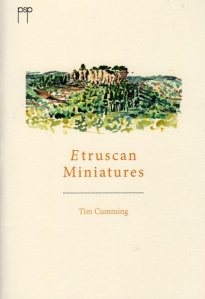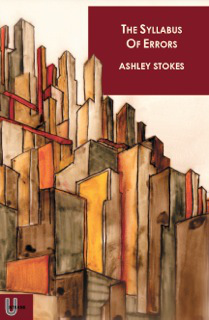-Reviewed by Afric McGlinchey–
I love poets who are also visual artists – it brings something extra to their work. Tim Cumming, who was born in an orphanage and grew up in the West Country in England, is a film-maker and painter as well as a poet. This beautiful chapbook, produced by an Australian publisher, is Cumming’s sixth collection, and it is illustrated by his own watercolours, or ‘field paintings’ as they are described.
The poems and paintings take us to a summer in Umbria, Italy, within view of a medieval palace, vineyards and ‘the dramatic tufa of Rocca Ripesena, favoured by Pope Boniface VIII’ we are told. (The same pope who was consigned to hell in Dante’s Divine Comedy.)
The collection opens with a small cameo introduction, where a Leica camera, a child’s chicken pox and a certain light all coincide at a ‘point of the compass/that once disputed/with ocean currents.’ Immediately, the reader is alerted to a setting where past and present merge though both personal and panoramic image.
This alternative perception is revealed again in the poem ‘Orvieto’, which introduces the town via its substrata: ‘Fish bones swam/through Orvieto’s/limestone tufa’. Later in the poem, ‘the ghost flicker/of dead trades and traders’ is seen in the details of frescos, with their ‘bright colours…egg tempura’. Continuing to describe the place from the bottom up, ‘Procession’ introduces the ‘caves for wine/ and birds fattened/ for feast tables’. Pattern and symmetry are important to this poet, who associates the ‘mist rolling in’ with the ‘Holy See’.
In Sean Borrodale’s collection, The Bee Journal, he notes the day to day happenings of the hive as he witnesses them. Here, Cumming observes the slow activity of the growing grapes in this beautiful landscape:
‘Toscano grapes, cool
conductors of white lightning
awaiting the still and
blend and ripening
in cellar chiaroscuco’
Like Borrodale, Cumming’s interest is in the minutiae of nature: he notes, in ‘Surface Depth’, ‘raindrops exploding/on the surface of the pool…the colours of impact and submission’. But sometimes, his associations are more laboured and unconvincing than they might be. The moment here moves from ‘plunging in/deep to life beyond reason’ to ‘tuning in to a tongue beyond reason’ in a corner café in Budapest. I feel the language could have been more accurately and delicately wrought here.
There is an impressionism to his observations. In ‘Mushroom Robert’, a morning mist, across a landscape where deer are grazing, creates the sense of a ‘crumpling hallucination/that swam through every mammal/like images on a closing fan’. There is a self-conscious self-awareness too, in his own placement in this setting: ‘We’re the last ones standing,/scattered around the terrace/like Etruscan statues’. Again, his associations conjure a geographical and psychic leap, between the mushroom-eating Robert (‘the human brain scrabbling for highs’) and ‘the sorcerer at Chauvet dancing/to Bowie tunes from Scary Monsters’.
‘Watermelon’ describes, in two sentences, both a physical and metaphorical journey: ‘wheel-buckling tracks’ which challenge the ‘next hairpin of a marriage’. This poem conveys through its vivid imagery, a strong impression of conflicting emotions: ‘we cleaved it in two and twice again/and shared it out like an urgent message.’ The ‘cleaving’ seems symbolically suggestive of an imminent parting, but the line continues: ‘burying our mouths in its soft pink oblivion’.
Oblivion appears to be a state of mind that is sought in this collection, as not only mushrooms but ‘the blossom of a young bottle’ lures with the possibility of ‘tak(ing) us bubbling’, and later (in ‘Fast Stars’), ‘we’re staring up at the Umbrian night sky/watching fast stars stir the drunken cranium’. Such sights lead to reflection: ‘In age, what we have left done or left awry/contains us like a landmark, an orbit’s/eccentricity/a destination in heavy weather/only we can see’.
Cumming’s free-associative, impressionist senses are enhanced in this setting, where a simple observation of last night’s debris, and anticipation of lunch, combine to flow, again in a single sentence, all the way to ‘the soul food kitchen/of Dante’s Purgatorio.’
More than anything, though, what the reader is conscious of (with the assistance of delicate blue and green and white watercolours) is Cumming’s visual focus: ‘The best pictures/are underlit’ he tells us, in ‘Exposure’: ‘a lighter trailing/a flare of gold over/moonbulbs of garlic’, which cause him to make a mental leap to ‘the sexy buttocks/of a spear-carrying/centurion turning against/the writhing of the sun.’
This chapbook, in spite of occasional false notes, is a pure delight. As a reader, you feel yourself cavorting through this ravishing landscape, into frescoes, into history and myth, below ground, and to other parts of the cosmos – all the while holding a dewy glass of white wine in your hand.








